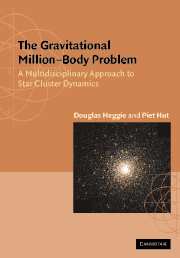Book contents
- Frontmatter
- Contents
- Preface
- PART I INTRODUCTIONS
- PART II THE CONTINUUM LIMIT: N → ∞
- PART III MEAN FIELD DYNAMICS: N = 106
- PART IV MICROPHYSICS: N = 2
- PART V GRAVOTHERMODYNAMICS: N = 106
- PART VI GRAVITATIONAL SCATTERING: N = 3
- PART VII PRIMORDIAL BINARIES: N = 4
- PART VIII POST-COLLAPSE EVOLUTION: N = 106
- PART IX STAR CLUSTER ECOLOGY
- 30 Stellar and Dynamical Evolution
- 31 Collisions and Capture
- 32 Binary Star Evolution and Blue Stragglers
- 33 Star Cluster Evolution
- Appendix A A Simple N-Body Integrator
- Appendix B Hints to Solution of Problems
- References
- Index
30 - Stellar and Dynamical Evolution
Published online by Cambridge University Press: 05 June 2012
- Frontmatter
- Contents
- Preface
- PART I INTRODUCTIONS
- PART II THE CONTINUUM LIMIT: N → ∞
- PART III MEAN FIELD DYNAMICS: N = 106
- PART IV MICROPHYSICS: N = 2
- PART V GRAVOTHERMODYNAMICS: N = 106
- PART VI GRAVITATIONAL SCATTERING: N = 3
- PART VII PRIMORDIAL BINARIES: N = 4
- PART VIII POST-COLLAPSE EVOLUTION: N = 106
- PART IX STAR CLUSTER ECOLOGY
- 30 Stellar and Dynamical Evolution
- 31 Collisions and Capture
- 32 Binary Star Evolution and Blue Stragglers
- 33 Star Cluster Evolution
- Appendix A A Simple N-Body Integrator
- Appendix B Hints to Solution of Problems
- References
- Index
Summary
Globular star clusters have an important place in modern astrophysics for several reasons, but let us mention just two here. Firstly, they are a laboratory for the study of gravitational interactions and dynamical evolution, and this is the motivation for much of the research that we have written about in this book. Secondly, however, each cluster is also a sample of stars of very similar age and composition, and are an ideal test-bed for theories of stellar evolution.
Over the years these two aspects of cluster studies built up their own communities of theorists and observers, and their own suites of problems (Fig. 30.1). Now what is remarkable is that, for many years, research in these two areas proceeded in almost total isolation from each other. It was possible to pursue an active and successful research career on one side of this diagram (Fig. 30.1) without even being aware of the existence of the people working on the other side. Whenever one did need something from the other side, the most primitive tool for the job was used. Dynamicists would use mass functions which to any observational astronomer would seem distinctly bizarre, while observers, if they ever needed a theoretical model, would dust off an old one which ignored decades of subsequent theoretical development. Dynamicists were fascinated by the problems of stellar systems with stars of only two different possible masses, while fitting a Fokker–Planck model was something that no non-theorist ever attempted.
- Type
- Chapter
- Information
- The Gravitational Million–Body ProblemA Multidisciplinary Approach to Star Cluster Dynamics, pp. 279 - 283Publisher: Cambridge University PressPrint publication year: 2003



